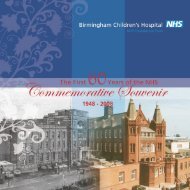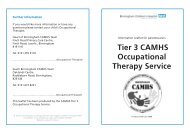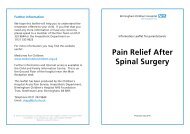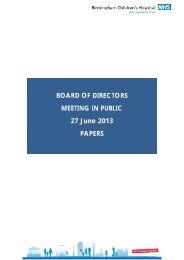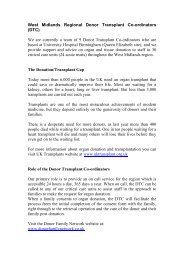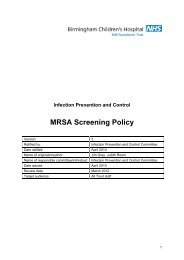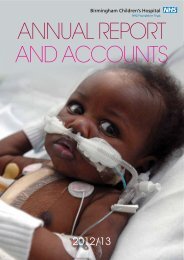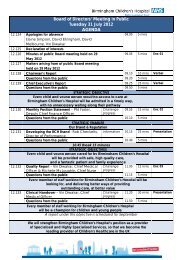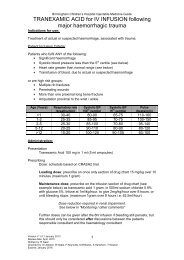ANNUAL ACCOUNTS 2009/10 - Birmingham Children's Hospital
ANNUAL ACCOUNTS 2009/10 - Birmingham Children's Hospital
ANNUAL ACCOUNTS 2009/10 - Birmingham Children's Hospital
- No tags were found...
You also want an ePaper? Increase the reach of your titles
YUMPU automatically turns print PDFs into web optimized ePapers that Google loves.
<strong>Birmingham</strong> <strong>Children's</strong> <strong>Hospital</strong> NHS Foundation Trust - Statutory Accounts Year to 31 March 20<strong>10</strong>Retirement benefit costs (continued)For early retirements other than those due to ill health the additional pension liabilities are not funded by the scheme. The fullamount of the liability for the additional costs is charged to expenditure at the time the Trust commits itself to the retirement,regardless of the method of payment.1.04 ExpenditureOther operating expenses are recognised when, and to the extent that, the goods or services have been received. They aremeasured at the fair value of the consideration payable.1.05 Property, Plant and EquipmentCapitalisationNOTES TO THE <strong>ACCOUNTS</strong>Property, plant and equipment are capitalised if the assets are capable of being used for a period which exceeds one year and:- they are held for use in delivering services or for administrative purposes;- it is probable that future economic benefits will flow to, or service potential will be supplied to, the Trust;- individually have a cost of at least £5,000; or- they form a group of assets which individually have a cost of more than £250, collectively have a cost of at least£5,000, where the assets are functionally interdependent, they had broadly simultaneous purchase dates, areanticipated to have simultaneous disposal dates and are under single managerial control; or- they form part of the initial setting-up cost of a new building or refurbishment of a ward or unit, irrespective oftheir individual or collective cost.Where a large asset, for example a building, includes a number of components with significantly different assetlives, the components are treated as separate assets and depreciated over their own useful economic lives.Where subsequent expenditure enhances an asset beyond its original specification, the directly attributable cost is added tothe asset‟s carrying value. Where a component of an asset is replaced, the cost of the replacement is capitalised if it meets thecriteria for recognition above. The carrying amount of the part replaced is de-recognised.ValuationAll property, plant and equipment are measured initially at cost, representing the cost directly attributable to acquiring orconstructing the asset and bringing it to the location and condition necessary for it to be capable of operating in the mannerintended by management.All land and buildings are revalued using professional valuations in accordance with FRS 15 every five years. Athree yearly interim valuation is also carried out. Valuations are carried out by professionally qualified valuers inaccordance with the Royal Institute of Chartered Surveyors (RICS) Appraisal and Valuation Manual. A fullasset valuation has been undertaken based on the "Modern Equivalent Asset Valuation" method as at 31 March 20<strong>10</strong>.Until 31 March 2008, the depreciated replacement cost of specialised buildings has been estimated for an exact replacementof the asset in its present location. HM Treasury has adopted a standard approach to depreciated replacement cost valuationsbased on modern equivalent assets and, where it would meet the location requirements of the service being provided, analternative site can be valued. HM Treasury has agreed that NHS trusts must apply these new valuation requirements by 1April 20<strong>10</strong> at the latest. The Trust has considered this option, but has decided not to proceeed with this option at this time.Page 6




